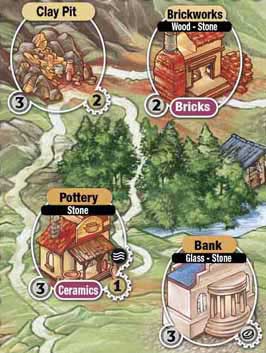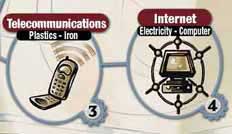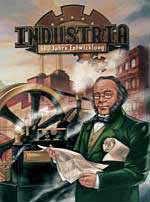The theme is industrial development and Industria is structured into five epochs. As is the board. While the epochs divide the board horizontally, it is also divided into two vertical sections. The larger section shows different ‘factories’ for each epoch. These start with quarries and mines and progress through iron and steel production to biotechnology. The smaller section shows technologies. From early machines through steam engines to telecomms and the internet. There are also sets of 12 square tiles for each epoch. There is one of these for each of the factories and technologies. Plus one each of the raw materials produced in the epoch and a couple of bonus tiles. The bonus tiles each show a symbol and players score extra points at the end of the game for owning factories with symbol(s) that match the bonus tiles they hold. The raw materials introduce another factor into the game. The right raw materials are needed to build each factory (except in the first epoch, when most are built from scratch) and technology. Each raw material is produced by a specific factory: the foundry (epoch two) produces iron, for example. Once the foundry has been built, players can buy iron from the player who owns it. From epoch three iron can be bought from the bank, if the foundry isn’t in play. Until either of these happens, the raw material tile is the only iron available. Which makes it very valuable in the short term. The heart of Industria is auctioning the tiles. The first player draws as many tiles as there are players and reveals them. S/he then picks one to sell off. Going once round the table, the other players either bid (above any previous bid) or pass. When the round gets back to the auctioneer, s/he can sell the tile to the highest bidder for the cash and choose the next item to auction. Alternatively, s/he can keep the tile, paying nothing for it (and must do this if nobody has bid). However, in this case, s/he is no longer the auctioneer and must pass the remaining tiles to the next player to continue the auction. The auctioneer’s choice is between getting money or a tile. And money is tight. You start with four ‘dollars’. Factories cost 2-3 dollars to build (paid to the bank) and usually need 1-2 raw materials (probably costing a dollar each). So, on the first turn, bidding even one dollar for a factory may mean you can’t afford to build it that turn. Everybody gets a welcome income of one dollar each turn, but gaining more money during the game is important. Hence the value of factories that produce raw materials that other players will buy. And the value of being auctioneer and gaining the cash for selling things off.  The auction out of the way, players build tiles from their hand, placing them face-up on the table. Tiles may be held for subsequent turns (but unplayed tiles are worthless at the end of the game). As I’ve already mentioned, factories cost cash and raw materials to build. They may score victory points when built, provided they’re built in the same epoch as they were bought. Alternatively, they may bring in income. Or both. And they may score bonus points at the end of the game: both through the bonus tiles and by being connected by ‘roads’ on the board. Building a technology requires raw materials, but no cash, and scores victory points immediately. However, they can only be built in the right epoch. They can also score bonus points at the end of the game through the connections between technologies on the board. Bonus tiles cost one dollar to build and then sit in front of you until the end of the game. You’re allowed to build one of each type in a turn, so bonus tiles are often not revealed until the end. Just remember that you need cash to play them! Finally, raw material tiles are used when a particular raw material is needed. You can also trade them back to the bank for a dollar – a neat touch that ensures they have a value. Players mark what they’ve built on the board with a cardboard chip in their colour and mark their score with another chip on the scoring track at the bottom of the board. As you can see, there are a lot of factors to be taken into account when bidding for a tile – particularly if it’s a factory. How much does it cost to build? Are the raw materials available to build it? Can I afford to buy them? How many points does it score? How much income is it worth? Does it add to my bonuses? And, having weighed up these factors, you have to think about the tactics of the auction. What tiles will other players buy? Or, if you’re auctioneer, will they all pass? This would force you to take a tile you don’t want and lose control of the auction. Which is why, faced with a tile I really want, I may well just take it and pass the auction to the next player! The tiles available in the auction are crucial. For example, if a technology comes out in the last auction of an epoch, you have to know you can get the raw materials it needs, or it’s worthless. And it’s real pain if both technology tiles come up in the last auction of an epoch. There is, therefore, an element of forward planning in the game. You know what tiles are going to appear in each epoch. You don’t know what order they will come out in. So you need to have an idea of which tiles you want and re-consider this after each auction. You also need to look for combinations – the raw material(s) that are needed for a particular factory or technology in particular. Once everybody’s had a chance to build, it’s the end of the turn. The start player marker moves round (from the person who was the first auctioneer on that turn), everybody gets a dollar and the new start player turns over the next set of tiles. The only difference a change of epoch makes is that a new stack of tiles is started. And players get an extra dollar each (except between epochs 1 and 2).  At the end of the last turn (end of epoch 5 with four players, 4 with three), players score their bonus points. Each bonus symbol tile in front of a player scores 2 points for each factory with that symbol that s/he owns. Each pair of factories or technologies connected on the board and owned by the same player scores 3. And players score a point for every 3 dollars they have left. With factories scoring 0-4 points and technologies 2-5, the final bonuses are significant. Having said that, the games I’ve played have usually ended up with pretty close scores. It’s worth mentioning two ‘factories’ that are special: the Bank and Stock Exchange. They are relatively expensive, but the reward they bring is a discount on the cost of building each subsequent factory. Very useful to have, but I must report that I still win the game without owning either! So, what makes this game so good? I think it’s a combination of the scarcity of cash, which restricts your options, with the different ways of scoring points –which give you many options. Plus the need to make decisions and the close scores. There’s certainly a risk of the game slowing right down as players analyse their position and options. But this has not happened in the games I’ve played. As the order the tiles appear in is random, there’s no point in analysing things too deeply. It’s certainly possible to have a strategy – after the first few turns anyway – but you can’t afford to follow it slavishly. You also need to plan ahead: you have limited money and limited time to do things. This is important for the last turn of each epoch, which is your last chance to score points for building that epoch’s tiles. And also in the last couple of turns in the game – to make sure you have the time and money to build everything you need to. All in all, Industria is a terrific game that provides a challenge each time you play it. I am surprised that nobody seems to be planning an English-language edition. At the moment it is only available from Queen Games in German. An excellent set of rules in English is available from Michael Schacht’s own website, along with a full colour version of the board in English (not that there’s much text on it). Industria was designed by Michael Schacht and published (in German) by Queen Games. It is a strategy board game for 3-4 players, aged 10+ and takes about 90 minutes to play. It is available in specialist games shops in the UK at around £20.
Page created 4th April 2004. Last updated 24th June 2005. This website produced by Paul Evans. © Copyright Paul Evans 2004-2005. All trademarks acknowledged. Illustrations courtesy of Spiele aus Timbuktu. Problems, comments and feedback to the Webmaster. |
Pevans |
 Designer Michael Schacht has had lots of games published in the last few years. His designs are usually clever, abstract game systems with a veneer of theme. My reactions to these have been mixed. I find some of his games quite brilliant – like my favourite to date, Kardinal & König (known as Web of Power in its English-language incarnation). Others do my head in (no names, no pack drill). I am pleased to report that Industria (published by Queen Games) is quite definitely in the former category.
Designer Michael Schacht has had lots of games published in the last few years. His designs are usually clever, abstract game systems with a veneer of theme. My reactions to these have been mixed. I find some of his games quite brilliant – like my favourite to date, Kardinal & König (known as Web of Power in its English-language incarnation). Others do my head in (no names, no pack drill). I am pleased to report that Industria (published by Queen Games) is quite definitely in the former category.